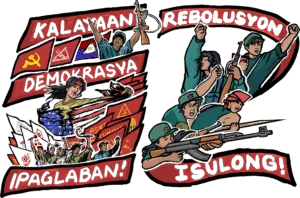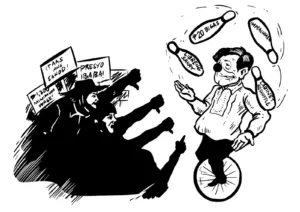The consecutive devastation caused by Typhoons Kristine and Leon inflicted widespread suffering to farmers, fisherfolk, and the urban poor. As in the past, the Marcos regime’s incompetence in preparing for the typhoon’s impact and the fragile public infrastructure marred by corruption has once again been exposed.
Moreover, Marcos ignores and confounds the fact that this is a result of the accumulated destruction of the environment. He continues to support unbridled logging and mining, dam projects and other infrastructure, land reclamation, and real estate construction that bring about destruction.
Widespread devastation
The National Disaster Risk Reduction and Management Council (NDRRMC) recently reported that the consecutive typhoons ravaged at least 8.7 million Filipinos or 2.2 million families in 12,192 barangays in 17 regions, and forced 748,991 people to evacuate leaving many of them in evacuation centers.
A total of 211 cities and municipalities have declared a “state of calamity” due to the damage. Death toll reportedly reached 150, while 134 are injured, and 20 remain missing.
The heavy rainfall highlighted the lack of preparedness and the inadequacy of the positioned equipment and aid to swiftly assist the areas affected by the flood. In Bicol, merely on the second day of relentless rainfall brought by Typhoon Kristine, the Regional DRRMC announced the suspension of its rescue efforts because its equipment and personnel could no longer handle the extent and severity of the damage.
The typhoon exposed the substandard government roads, bridges, and infrastructure in the region. The destruction of hundreds of roads and bridges hindered those who wanted to provide aid from immediately reaching many areas.
In the past few weeks, Marcos has been making pretentious visits to the affected areas by helicopter and luxury vehicles. Bureaucrat capitalists are also taking advantage of the situation to pocket millions of pesos in profits and to grandstand in preparations for the upcoming 2025 elections.
The agricultural sector reportedly suffered at least ₱6.4 billion in damages as of November 6. However, the Philippine Crop Insurance Corporation will only provide ₱600 million to affected farmers. Farmers have long been complaining about the inadequate insurance and cumbersome registration process.
Collective demands
To hold the Marcos regime accountable for its responsibility amid the calamity, farmers and fisherfolk stormed and protested at the Department of Agriculture in Quezon City on October 29. Along with environmental groups, they also went to the Department of Environment and Natural Resources to hold the agency accountable for its role in environmental destruction.
They said that the occasional aid is not only measly, but also fails to cover all those affected. They demand the Marcos regime to provide long-term compensation in the form of payments and rehabilitation of damaged farms, communities, and fishing grounds.
The re-organized People Surge, a national alliance of advocates for the rights of disaster survivors, joined the action. The alliance was historically formed and widely mobilized during super Typhoon Yolanda under the Aquino II regime.
The Makabayan Coalition is calling on the Marcos regime to establish a “State Compensation Fund” to provide direct financial support to those affected by the typhoon, especially farmers.
It proposed to use the ₱10.29 billion CIF (Confidential Intelligence Fund) budget, of which ₱4.5 billion is directly controlled by Marcos, to distribute free seedlings, fertilizers and equipment to farmers, and subsidies for damaged infrastructure and inventory for small businesses.











